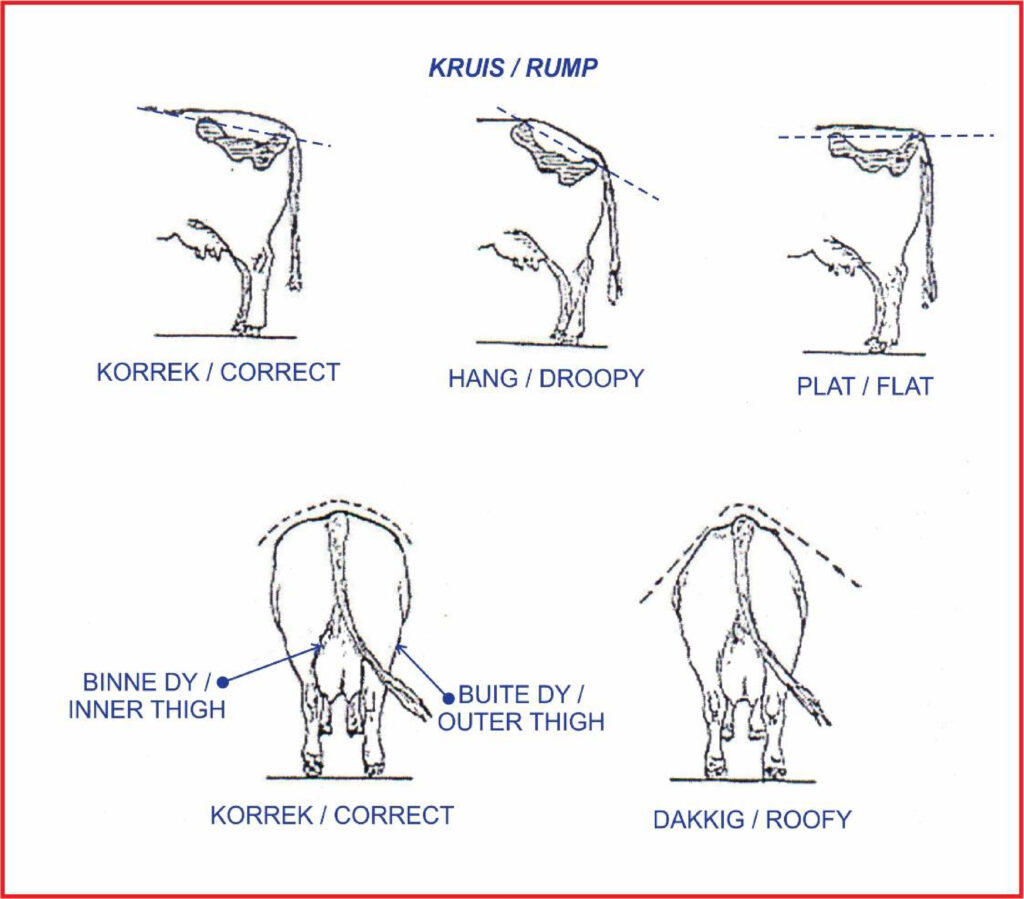Beefmaster SA Standard of Excellence
1. Size and Capacity
The Beefmaster is known for it’s weight gain and animals should show good weight for their age. They should be well muscled and long bodied with a relatively large capacity. The female must have good body length and relatively large capacity.
2. Skin, Hair and Bone
- Colour: The Beefmaster has no specific hair colour as it plays no role in functional efficiency. Selection for specific colour pattern is allowed if preferred. Inspectors will not discriminate against colour.
- Hair: Short, dense, shiny and smooth.
- Skin: Of medium thickness, loose and supple with ample pigmentation.
- Bone: Strong, dry and durable, excessive thickness or fine bone structure is undesirable. Joints strong and dry
3. Head
Obvious masculine and strong. Well placed bright eyes, with a robust yet calm expression. Of medium length and width. Face is sharply outlined with well-developed eye brow-ridge.
A typical head must display femininity. Eyes well placed and clear, with a watchful yet calm expression.
Wide with good width between the eyes.
Broad, oval and strong. Of moderate length.
4. Neck
Bulls: Masculine, with clear definable muscularity. Sharply outlined with well-developed hump. Neck well attached and must be neatly merged with the head and shoulders. Darkening of color on neck and forequarters is preferable.
Female: Of moderate length, flat, with very neat feminine look. The neck of the female must not show signs of a darker coloration than the rest of the body.
5. Forequarters
Shoulders:
Bulls: Even with the back, well muscled, should move freely and merge correctly into the body. Not to loose and shoulder blade must have the correct angle
Female: Even with the back, not heavily muscled, neat, should move freely and merge correctly into the body.
Chest:
Bulls: Deep, wide between the forearms. Over prominent shoulder are undesirable.
Female: As for the bull, but not as massive and broad. A prominent brisket, which shows a heavy fat deposit, is undesirable.
6. Mid Section
Girth: Deep, wide with good arched of front ribs.
Ribs: Long, flat and well arched, and is slightly inclined towards the back. In bulls – deep through chest section.
Ribcage: Long and relatively deep, with good capacity and spring of rib.
7. Back (Withers and Loin)
Withers:
Straight, strong and wide.
Loin:
Bulls: Broad and strong, prominent and well-defined muscularity and must create the impression of strength. Well connected with the rump.
Female: Prominent, yet smoothly muscled. Definition of muscles should not be present, as in bulls. Well attached to the rump.
8. Hind Quarters
Hipbones:
Bulls: Fairly wide apart, but not as widely or prominently apart, that an impression of femininity is created.
Female: Wider apart than in the case of the bull and without any excess fat deposit.
Rump:
Long and wide and slightly rounded on top. Slightly sloped on both sides of the tail attachment, and slightly sloping downwards from the hipbones to the pin bones.
Pin bones:
Wide apart and placed slightly lower than the hipbones.
Thurls:
Wide (widest part of the animal). From here a progressive wedge should be visible, wider at the back and smaller to the front.

9. Thighs
Bulls: Long and distinctly defined muscularity must be shown in a full inside- and outside thigh, which goes down to the heel. A broad second thigh should also be present.
Female: Long, flat and smoothly muscled down to the hamstring.
10. Tail
Neatly attached to the body, and hanging straight down. The tail should hang at least on the hocks and show a well-developed tail brush. A prominent tail-root is undesirable.
Reproduction
Male and Female
Testes: Must be well-developed and equal in size and must extend low into the scrotum.
Scrotum: Show a well-developed neck, not twisted and not hanging too far down. (Not pendulous)
Well-developed with no signs of infantilism or malformation.
Reproduction
Male and Female
Testes: Must be well-developed and equal in size and must extend low into the scrotum.
Scrotum: Show a well-developed neck, not twisted and not hanging too far down. (Not pendulous)
Well-developed with no signs of infantilism or malformation.
13. Milk Production, Udder and Teats
In the female a sufficient milk production potential must be shown with an absolute feminine attitude. Teats uniform, cylindrical in shape, squarely placed, hanging straight down and medium length (6-8cm). Udder should be well attached, supple and elastic, covered with fine, soft hair.
14. Legs and Hoovers
The animal must stand squarely and move with a comfortable free gait.

Front legs: Strong. Medium length with moderate bone. Must show a slight inclination from elbow to knee, but should be straight and squarely placed from knee to hoof.
Hind legs: Strong, of medium length with moderate bone. Viewed from the side, the hooks should form the desired angulations. Straight and square, when seen from behind.

Hooves: Of good size, oval and deep. Hooves must face forward, with tight fitting hooves, amber to black in color.
15. General Apperance
Large, well balanced and symmetric. Good length and width of body. Outstanding genuineness of gender with a gentle temperament. The animal must show quality and strength and should move freely on four strong legs.
Masculine, robust and strong, with a good attitude and vitality. Well-defined muscularity must be shown over the shoulders, back, loin and thighs and forearms. Obvious width from the front and from behind. Medium sized. Coarser skin, hair and bone than the female animal with a deeper, better developed forequarter.
Finer in every respect than males and display total femininity. Well, but smoothly muscled. When in milk production less muscling should be displayed, and the framework should be more visible. Viewed from the side, the hindquarter should be deeper than the forequarter, showing a somewhat typical female, wedge-shaped appearance. A well developed and well attached udder with four well-placed teats of moderate size.
The bull must have a strong and powerful male appearance, whereas the cow should be finer and feminine.







